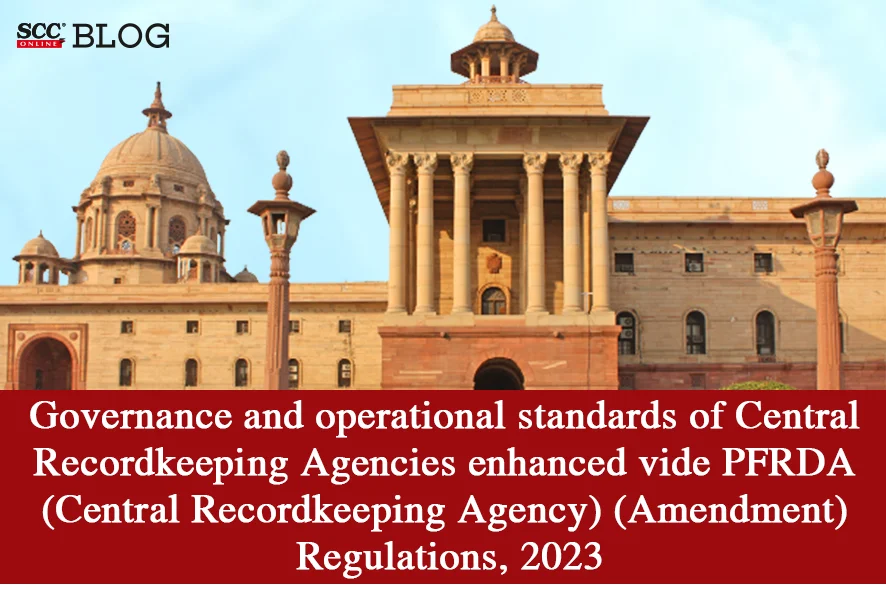On 9-2-2024, the Pension Fund Regulatory and Development Authority (‘PFRDA’) notified the Pension Fund Regulatory and Development Authority (Central Recordkeeping Agency) (Amendment) Regulations, 2023 to amend the Pension Fund Regulatory and Development Authority (Central Recordkeeping Agency) Regulations, 2015. The provisions came into force on 9-2-2024.
Key Point:
-
The objective of the newly introduced amendment aims to specify eligibility criteria and set standards for technology architecture, refine operational standards and governance for Central Recordkeeping Agencies. This will help to safeguard the interest of the subscribers.
-
The definition of “key personnel” has been introduced covering key managerial personnel, non-executive directors, compliance officer, principal officer, person designated/ instructed by board/ Authority for recordkeeping and head of the department of cybersecurity, operations, risk management, technology under its ambit.
-
Regulation 4 relating to “Eligibility criteria” has been revised to ensure that only the capable and experienced entities manage the record keeping. The applicant will have to fulfil the following criteria:
-
Applicant should be an incorporated body having 5 years of experience and have already managed over 5 lakhs unique customer accounts per year over the preceding 3 financial years.
-
Applicant should have a net worth of at least Rs. 100 Crore, on the last day of the preceding financial year and has made a profit after tax in at least three out of the five preceding financial years.
-
Applicant should also possess information technology capabilities, experienced manpower of at least one hundred professional staff and experience of developing and managing technology-based administration and recordkeeping system.
-
Applicant should not hold or control 20% or more of equity share capital.
-
-
Regulation 7 relating to “Verification of information” has been revised.
Earlier parameters of verification were physical verification of documents, office space and inspecting the availability of office space, infrastructure and technological support.
Now, the parameters of verification include verification of documents, inspection of infrastructure, and resources, including technological capabilities which the applicant is required to fulfil and is also required to seek report from agency bearing the application.
-
Rejection of Application – The Authorities will have to give the applicant notice before rejecting the application and the applicant will have to rectify the defect within 15 days.
-
Regulation 10 relating to “Conditions of certificate of registration” has been revised and a provision has been introduced according to which any certificate of registration which is granted by the Authority will be subject to the condition that it will have to submit a certificate evidencing compliance with the eligibility conditions.
The certificate will be placed before its board and its observations along with explanation will be submitted to the Authority, within 60 days from the end of the financial year, or within 60 days from the expiry of tenure of its registration.
-
Earlier, an amount Rs. 25 Lakhs was paid by the applicant as the Registration fee.
Now, along with the fees, the applicant will have to pay the applicable taxes and levies thereon.
-
Accordingly, the applicant will now have to pay the Annual Fee plus applicable taxes and levies thereon, quarterly at the rate of 0.05 times the service charges.
-
Earlier, Regulation 14 related only to “Commencement of Operation”. Now, the ambit of Regulation 14 has been increased and the regulation now relates to “Commencement of Business”.
-
The validity of the Registration Certificate will remain valid unless cancelled by the Authorities.
-
The Central Record Keeping Agency, along with the other responsibilities, will also have to take all measures necessary for prevention of fraud and develop and implement a fraud prevention and mitigation policy which will include:
-
laying down internal controls to be followed and ensure that such controls are adequate and operating effectively;
-
making provision for indemnifying the subscriber for any loss on account of fraud or negligence on the part of the central recordkeeping agency
-
-
The Central Recordkeeping Agency will have to submit its Annual Report to the authorities which will include:
-
A certificate by the chief executive officer addressing the following responsibilities:
-
adequacy and effectiveness of internal processes and digital architecture controls;
-
compliance with the provisions of the Act, rules, regulations, guidelines, circulars, directions and instructions issued by the Authority, besides other applicable laws;
-
adherence to the code of conduct.
-
-
Audit report containing audit of process, operations and accounts of pension schemes.
-
-
Exit Management Plan: A Central Record Keeping Agency must submit its exit plan to the Authorities within 6 months from commencement of business and it must be updated and submitted within 30 days from the end of each financial cycle. It should contain-
-
a detailed program of the transfer process
-
modalities for communication
-
provisions for contingent support
-
-
Schedule IV has been inserted which relates to Criteria for determining a “Fit and Proper Person”.
-
Schedule V relating to Certificate of Commencement of Business has been inserted.






